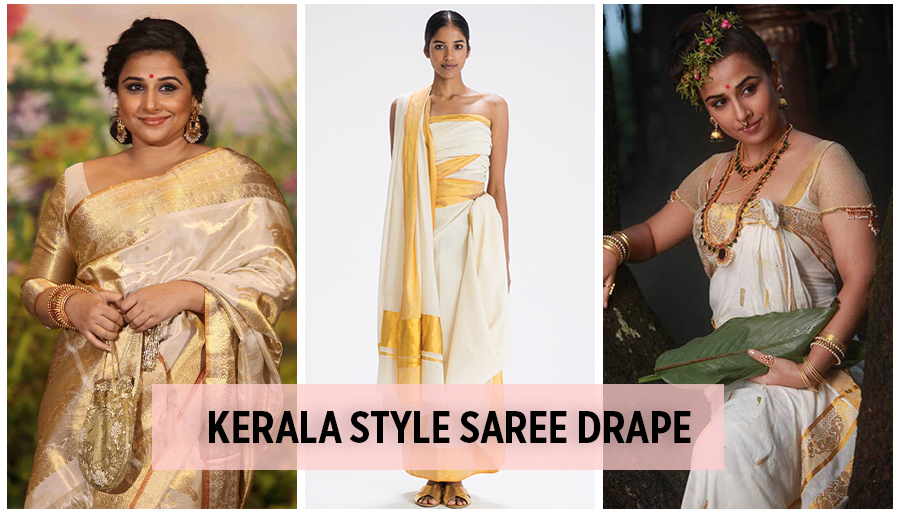A saree is a piece of apparel connected with Indian culture and religion. Traditionally, a saree is an Indian dress. Typically, sarees measure approximately 6 to 9 yards in length. Which is the one that is wrapped around the waist and draped over the shoulder? There are several ways to wear or weave a saree. It is typically worn with choli and an underskirt. India’s saree is recognized as a cultural icon. Which is extremely luxurious and comfy.
A Saree the word that evolved from “Sattika” is the Sanskrit word. So, The saree is advanced from a three-piece comprising the “Antriya”, which is the lower piece of clothing. And the “Uttariya” which the shroud wore over on head from the shoulder, and the “Stanapatta” which the Chest Band.
We have a lot of varieties in regional saree likewise handloom sarees, made of silk, cotton, ikkat, block-print, embroidery, and tie-dye.
Most importantly we have brocade silk sarees like Kanchipuram, Paithani, Uppada jamdani, Bhagalpuri or Tussar Silk, Baluchari sari, Maheshwari, Chanderi, Banarasi sarees.
We have a variety in silk, ikkat, and cotton sarees are likewise Patola, Pochampally, Bomkai, Khandwa, Sambalpuri, jamdani, Tant, Chanderi, Maheshwari, Manipuri, etc. And if we’re talking about the Tie-dyed and Block-print sarees are like Bandhani, Leheria, Bagru, Bandhej, Ajrakh, Sungudi, Bagh, Kalamkari. So, in this blog, we cover the different styles of Kerala saree draping with different types of sarees.
Different types of Kerala Sarees
The silk sarees of Kerala are the best examples of the excellent work of the talented weavers of India. Silk has an amazing luster, good durability, and a smooth, soft texture that is not slippery. That is the reason why Kerala silk sarees are the best. With the texture of silk, pattern, and fine figures, the floral design makes silk unique.
There are four types of silk in India: Mulberry, Muga, Tusser, and Eri silk. Kerala is one of the best silk makers in India. Kerala has an important role in the silk industry to make pure silk in India. The basic saree of Kerala has a gold and white silk saree with a gold border all over the saree.
This is the Mundum Neriyathum, Kerala Saree.
This is the oldest form of saree in India from Kerala. We can say that this is the symbol of the culture of Kerala. Mundum Neriyathum has an important role in Malayali culture. So, this is the basic Malayali outfit of India. This resembles the modern saree and nivi style more closely.
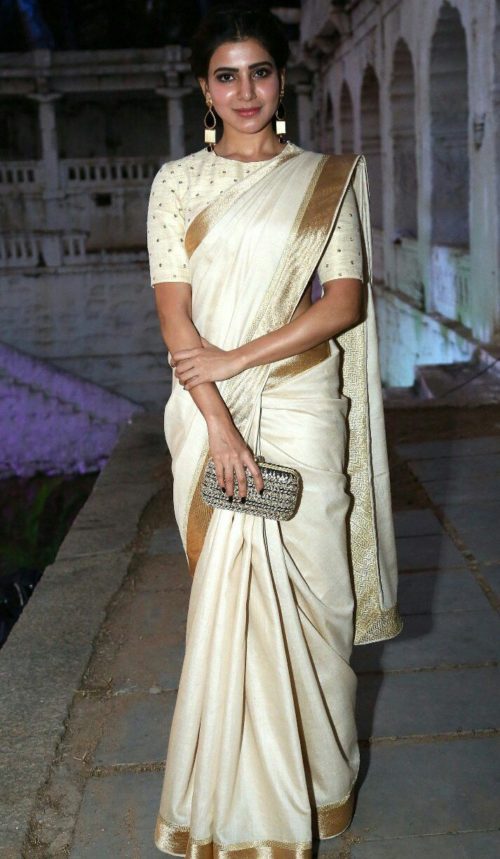
Therefore, some people believe that the nivi style saree evolved from this traditional saree. This is a very unique style of draping saree compared to others. It’s two main pieces. A Mundum is a type of lower garment worn around the legs as part of a saree. Consequently, men in Kerala also wear this form.
The Stunning Cotton Saree from Kannur
Kannur is also known as Cannanore. Cannanore includes a rich tradition of handloom weaving. So, we all know that cotton is a very comfortable fabric. Therefore, it has awesome absorbing power, great strength, etc. It has a border that is usually made with silk weaving. Peacocks and floral designs are a major attraction for handlooms. These types of sarees are light and are especially comfortable to wear.

Because of the tropical climate of Kerala, they are making cotton for all the regions. Cotton sarees are simple to wrap, carry, and lightweight. They will stay in place for hours after they are pinned.
The cotton saree is very simple and elegant. And it does not require many accessories. Colors, motifs, prints, borders, and embroideries are all evolving to be in trending styles. We can give extra points for cotton’s durability.
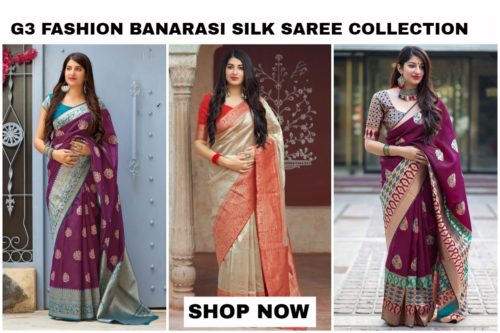
Saris from Balaramapuram Kerala.
Balaramapuram is famous as the center of the production of traditional varieties of handloom sarees. So, it has unique craftsmanship that makes it ideal. The weaving of Kerala has now spread all over the world. This weaving is from the Saliya community, which originally wove fine quality cotton silk.
In other words, it is one kind of weave that is generally done on saree borders with zari. Most importantly, it comes in a cream color. This is like ivory, and the beauty of the handloom attracts everyone’s attention. It has its mark to make it in the present space of the Kerala handloom industry in the production of various types of artistic handloom goods in Kerala.
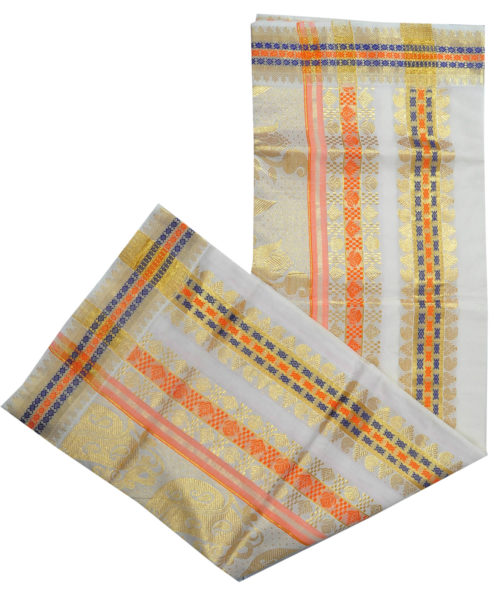
The Balaramapuram sarees, which are also called “Kerala Kasavu sarees”, have a special reputation across the world. It has the finest count of silk and natural color, which makes it even more amazing. Therefore, Kerala is also known as an unbleached cotton handloom which is crepe.
Maradaka silk (Matka silk) Kerala saree
Silk is the most expensive fabric. That’s the one article of clothing that each lady wishes to have in her closet. Therefore, silk is a symbol of purity, richness, and elegance. We Indians have beautiful silk fabrics that we weave into sarees.
If we’re talking about Matka silk, Which is commonly known as in India’s rough handloom variety of silk? Matka silk is a particular variety of silk that is made from mulberry silk with short silk filaments that are still coated with the gum (sericin) that are spun by hand. That’s why we have a wide range of embroidery and printed sarees in this style.

The Matka silk saree is very basic yet elegant. So, it’s easily worn at home, at work, or during casual family work. The breathable nature of the fabric makes it interesting. Generally, Matka silk is obtained from Karnataka and Kashmir, but most of the spinning is done in the Malda and Murshidabad areas of West Bengal. Some slugs and irregularities give the fabric a special character.
The Matka silk saree is usually woven with zari and gold thread. Normally, it’s in flower motifs. Recently, it’s been made in Kerala, which is also the same place in India. These kinds of silk sarees are simple to wear and carry, but look superb. It came with huge styles of silk, like Matka Silk Jamdani, digital printed Matka Silk, etc.
Note: If you have a pure Matka silk saree, wash it with mild detergent. And never keep it in direct sunlight. It can damage your Matka silk saree. It weakens the color as well.
The Kalpathy silk saree
Weavers from the Kuthampully town in Thiruvilwamala, Kerala, weave Kalpathy silk sarees. So, Kuthampully has established around 50 KM on the north side of Thrissur town. There are around 600 brahmin families that make the most exotic sarees in the nation. Most of them belong to the diving community. They weaved their origins in modern Kerala into this. That this is a community of traditional weavers was brought here by the Kochi royal family around 500 years ago. So, they want the traditions of the past to be overlooked.
The kasavu double dhoti set mundu is a well-known saree of this clothing. The Kasavu saree belongs to the Devanga community. Balaramapuram and Chendamangalam are also traditional designs for set mundu and saree. Their kuthampully sarees are some of the most wearable silk sarees outside the state. The kuthampully saree is quite popular in Kerala as well. It comes in a variety of sarees. Therefore, Kuthampully sarees come with jacquard designs which are regularly ornamented, setting them apart from sarees woven somewhere else within the state.
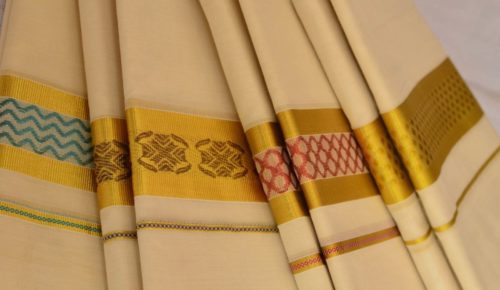
Kuthampully sarees are typically made from half-fine zari, which helps keep the cost down and makes it popular.
There is the Kasavu border, which does not extend to the border, and the rest of the gap is white. And it makes it unique. In other places in Kerala, the saree is generally woven in an off-white color and uses undyed cotton yarn.
Kurthampully took inspiration from the diving community of Mysore. They came under the guardianship of the Kochi royal family and originally had woven fabrics for the members of the palace, more like the Balaramapuram weavers.
Kasaragod, Kerala Sarees
Kasaragod is one of the finest districts in Kerala for silk weaving, and Mancheswaram is the main center. There is no difference in terms of design between Kasaragod and Mangalore silk. Both of the designs have the same motif. The weavers of Kasaragod are originally from the Padmashali community, who are from Mysore.

Most importantly, the Kasaragod saree is Kerala’s most popular saree. The Kerala saree is the most popular all over the world because of its simplicity, being natural cotton, and decorated with kasavu, without using another popular color or any zari ornamentation. The Kasaragod sarees are an aesthetic that remains relatively simple and sober in Kerala. Vat dyes are generally used for the Kasaragod sarees, giving them the color quickness compared to most of the other strategies.
The shirts are sold in huge numbers today and are woven with different patterns, colors, and zari. Nowadays, it comes in different colors.

Samudrika Puram silk and cotton-Kerala saree
Samudrika pattu saree is the original form of the Kanchipuram silk saree. Which is the typical traditional silk saree of Kerala? This is the pattu, Sarva Lakshana pattu, which looks amazing.
In Kerala, Samudrika pattu is generally worn for wedding functions. Which one is a symbol of truth, trust, tradition, and culture? Samudrika generally comes in red with golden zari weaving. Zari weaving is the symbol of handloom and Kerala is the state of weaving, where you can get lots of silk sarees with attractive motifs.

According to Hindu society, Kanchi silk weavers are the successors of Sakai Makanda, the master weaver who is supposed to have woven tissue from lotus fiber. Therefore, cotton is considered to be the favorite fabric of Lord Shiva. Moreover, silk was favored by Lord Vishnu. As we all know, the Indian traditional wedding dress (saree) is a combination of red and green with golden brocade.
Draping of different types of Kerala sarees
Kerala has many different styles of clothing. Here are some of them.
1.The Mundum Neriyathum-Kerala saree
This is the oldest form of saree in India from Kerala and a symbol of Kerala. Mundum Neriyathum plays a significant role in Malayali culture. This is the Basic Malayali outfit of India. This resembles the modern saree and nivi style more closely.
Some people believe that the nivi style saree evolved from this traditional saree. This is a very unique style of draping saree compared to others. It’s two main pieces. In lungi style, the Mundum or lower garment of the saree covers the legs. In Kerala, men also wear this form.
Drape Mundum Neriyathum Saree in Steps
1. Draping of lungi style Kerala saree Mundum Neriyathum
As we all know, this is the two-piece saree. It came with two pieces; one of them is smaller (Neriyathum), and the other one is bigger (Mundum) in length. So, the bigger one goes with your waistline and the smaller one goes with the upper part (pullu). Let’s start.
According to Hindu society, Kanchi silk weavers are the successor of saga Makanda, master of the weaver who is supposed to have woven tissue from lotus fiber. Therefore, cotton is considered to be the favorite fabric of lord shiva. Moreover, silk was favored by Lord Vishnu. As we all know, the Indian traditional wedding dress(saree) is a combination of red and green with golden brocade.
Draping of different types of Kerala sarees
There are a lot of styles that are usually worn in Kerala. Here is some of them, Likewise
1.The Mundum Neriyathum-Kerala saree
This is the oldest form of saree in India from Kerala and a symbol of Kerala. Mundum Neriyathum is an important role of Malayali culture. This is the Basic Malayali outfit of India. This resembles the modern saree and nivi style more closely.
Some people believe that the nivi style saree evolved from this traditional saree. This is the very unique style of draping saree from others. It’s two main pieces. The Mundum is a lower garment of saree which is wrapped around the legs in a lungi style. This form is generally worn in Kerala by men as well.
Drape Mundum Neriyathum saree Step by step
1. Draping of lungi style Mundum Neriyathum Kerala saree
As we all know, this is the two-piece saree. It came with two pieces, one of them is smaller(Neriyathum), and another one is bigger(Mundum) in length. So, the bigger one goes with your waistline and the smaller one goes with the upper part (pallu). Let’s start.
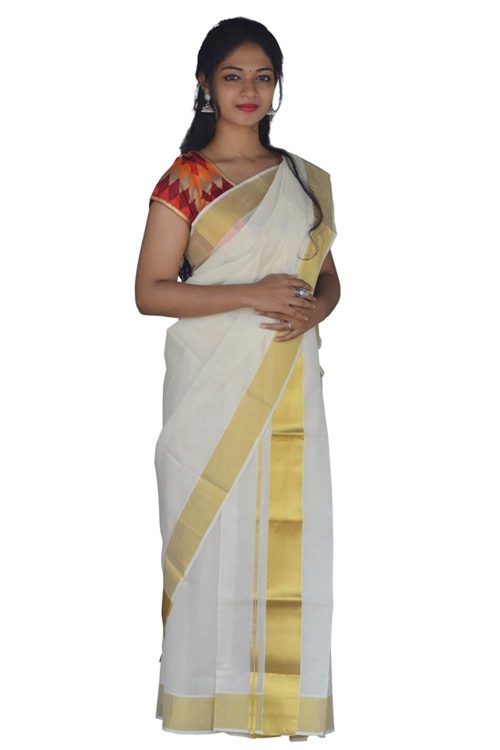
-
- Finish your look with the same gajra over your head.
-
- Take the lower part (bigger) from the end of the edge. And wrap it around your waistline to make sure that the golden border is at the level of your belly point. From right to left around your waist.
- Start from the center of your belly button. Make sure that the golden border of the saree ends at your center belly point and tuck it in with the same 1-2 pleats over there.
- Now start with the smaller (pallu) part.
- Now you need to take the upper part of the fabric and secure it with safety pins.
- And pin it over your shoulder. Pull the rest of the fabric from your right front to around your waistline to the left side.
- Give 1-2 pleats and tuck them with the help of a safety pin. Tuck them into your underskirt in front.
- Tuck your pallu and first pleat it with a blouse, then set your pallu.
-
2. Draping of the style Mundum Neriyathum Kerala Saree (without a lungi look)
As we all know, the Mundum Neriyathum saree comes in two pieces. If you don’t want to wear a two-piece saree. What you can do is just take one single (regular saree) and drape it like a Mundum Neriyathum Saree.
- Take your saree from the end of the age, tuck it in with your underskirt, and go from right to left around your waistline.
- Drape it around your waistline from the left side to the back, and tuck it in the center front.
- Then, first, mark where you want to start your pallu part.
- Then, at the center front, give 4-5 plates of the remaining part and tuck it into your center.
- Once your skirt part is done, start with the pallu part. Give pleats to the whole rest of the fabric and secure it with the safety pin.
- And keep it on your shoulder, from your right to your left shoulder.
Mundum Neriyathum saree is a set of two pieces (Mundus). Which is white and cream. These two pieces will have the same color, which is also known as a “Kara”. Mundum Neriyathum saree is also known as a “Kasavu saree”.
2. Namboothiri from Kerala
A Namboothiri is an ancient form of saree in India. Similarly, the Mundum Neriyathum saree draping style covers the lower body. The Mundum Neriyathum comes with two pieces of cloth. Just like this, it also comes in two pieces of cloth. Later on, this started to tuck into a blouse or leftover shoulder. The saree is commonly worn during the Onam dance. This also comes in two pieces of cloth; one is small and the other one is bigger.
1. Style DrapingNamboothiri Kerala Saree-Tucking into a blouse style
- Finish your look with the same gajra over your head.
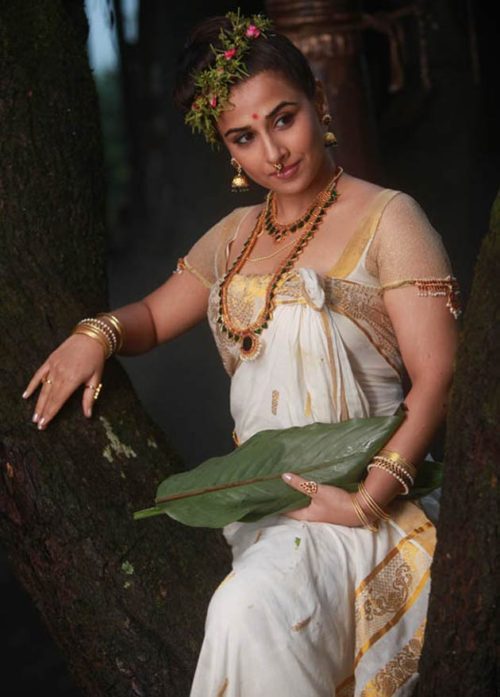
-
- Take the lower part (bigger) from the end of the edge, and wrap it around your waistline to make sure that the golden border is at the level of your belly point. From right to left around your waist.
- Start from the center of your belly button. Make sure that the golden border of the saree ends at your center belly point and tuck it in with the same 1-2 pleats over there.
- Now start with the smaller (pallu) part.
- Now you need to take the upper part of the fabric. And wrap it around your bust line. Secure it with safety pins.
- And tuck it into your blouse on the front side. If you have leftover fabric on your bust part, make a 1 bib pleat out of it and tuck it.
- Make sure that the golden zari border is coming up in front of your bust line.
- Finish your look with the same gajra over your head.
2. Draping the Namboothiri style saree with a normal one-piece Kerala saree
- Take your saree from the end of the edge and tie it. Tuck it under your underskirt. From right to left around your waistline.
- Drape it around your waistline from left to right, from the back of your waist to the center front.
- Then, first, mark where you want to start your pallu part.
- Then, at the center front, give 4-5 large plates of the remaining part and tuck them into your center.
- Once your skirt portion is done, begin with the pallu portion. Bring it around your chest to the front and make a few pleats and bring it up to your blouse front and tuck it into your blouse.
- Note: Make wide pleats because Kerala wants to make a wider pleat.
More about the saree:-How to wear a saree in pregnancy-Tips to know

